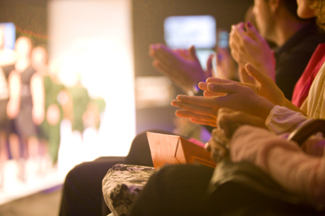 If the NEA’s 2008 Survey of Public Participation in the Arts and the roundtable discussion that accompanied its release last week are the kind of thing that floats your boat, I tossed my two cents into that pond here.
If the NEA’s 2008 Survey of Public Participation in the Arts and the roundtable discussion that accompanied its release last week are the kind of thing that floats your boat, I tossed my two cents into that pond here.
Aside from the clear need for a reassessment of the parameters we use when surveying American adults about their arts experiences (i.e. what counts as art in these times of dissolving definitions/genre hierarchies), the big, future-looking question the survey left me with was this: With all we have seen in the evolution of communications technology, is it possible that a trend of cultural participation will actually be seen and strengthened as audiences transition from a position of passive consumption to one of active and engaged parallel creation?

I believe that the shift from a “read only” experience of the arts to a “read/write” experience will be a great thing for both the artist(s) and the consumer(s)/devotee(s).
In music, I think of the sea change when music switched from a sheet music sales model to a recording sales model. Legions of people learned to play the piano so that they could experience classical music or facilitate popular music sing alongs. The corporate stress on recorded music served a profit interest for the sellers. Now we see the pendulum beginning to shift. Sales of recorded music are still up (but less profitable due to technological innovation), while sales of musical instruments and related technology are thriving. My proof is anecdotal, but I surmise that we will see a transition from classical music being a museum-piece to seeing contemporary classical music obtaining more of an audience. I think this is because when people can get inside a piece by playing it (or sequencing it, in the case of a synthesizer), then it’s easier to understand a piece.
I think that the new crafts movement has created not only amateur crafts folks, but a new market for crafts goods.
The list goes on and on.
I am now co-moderating a sound installation for an art museum in Oslo. My co-moderator and I created sound samples, and asked for new songs to be created using the samples. The resulting White Cube Remix, http://www.thewhitecube.info resulted in
94 Creative Commons licensed songs created in under 30 days and posted to ccMixter.org by 68 music-makers in at least 10 countries, in effect creating a 6 hour sound installation. But it has also generated interest in the exhibit at Oslo’s RAM Galleri.
The ideas of “imploding the white cube” acquired a poignancy for the music-makers, as well as for the 10+ video-makers that have already used the songs in viral video.
I’m not saying that all arts are now to be crowd-sourced. But I am saying that one element of arts appreciation is to actual engage in doing rather than just buying and listening. To me, that is the white cube that should be dissolved like sugar in hot chocolate.
David Byrne just wrote a blog post that, IMO, gets at the real problems of arts education and arts funding as well as, I think, the disinterest and/or disenchantment of audiences-in-general. Here’s the link: http://bit.ly/4mVSCG
Corey,
Thanks for that link! I’ve been feeling so much the same way, especially now that I’ve gone back to teaching the younguns.
cheers,
Andrea